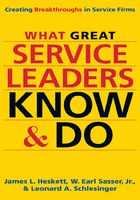
WHAT IS A BREAKTHROUGH SERVICE?
Standards for judging a service are highly subjective. When we first explored service breakthroughs and the organizations that achieved them, we described them as
those one or two firms in every service industry that stand out from the pack. . . . Firms that seem to have broken through some sort of figurative "sound barrier," that have passed through the turbulence that precedes the barrier into the relatively quiet, smooth zone beyond which a management action produces exaggerated results, results that often exceed reasonable expectations. Firms that alter the basis of competition in their industries.
Based on our experiences in recent years, we can improve on that vague, albeit inspiring, definition. It requires an understanding of the way in which value is created for customers, the employees who serve them, and investors.
Value Is Central to the Idea
When we talk with consumers, business customers, and even recipients of social services about value, four topics come up, time after time, in conversations: (1) results obtained from a package of products and services, (2) the quality of the experience in obtaining them, (3) the costs of acquiring them (other than price), and (4) price itself. Together, they make up a "customer value equation" (figure 1-1).
Figure 1-1 Customer Value Equation

Other things being equal, as results and quality of experience increase, value for the customer goes up. As price or costs of accessing the service increase, value goes down.
Recent research has explored the relative importance to customers of results (the what of service) versus experience (the how of service) in the customer value equation. It leads to the conclusion that when the service is performed in a customer's immediate purview or is being recalled shortly after the service encounter, experience is a more important influence on customers' perceptions of value. Otherwise, customer perceptions of value are more likely to be influenced by the results they realized.
The customer value equation reflects the extensive research on the topic of service quality carried out by Leonard Berry, A. Parasuraman, and Valerie Zeithaml in the past three decades. One of their early studies, based on interviews with 16 focus groups, concluded, for example, that customer expectations and the degree to which those expectations are exceeded or met on each of the dimensions of the equation determine customers' overall appraisal of service quality and value.
The employee value equation is based on research and employee interviews and can be stated in a similar manner (figure 1-2).
Organizations that deliver value provide employees with a reason to come to work (the nature of an organization's activities—its "business"—and its mission). They offer opportunities for personal development, frequent feedback, and ultimately greater latitude to solve problems for valued customers, all factors that contribute to the employee's capability to deliver results. The quality of the workplace is determined by such things as the "fairness" of one's manager (whether the manager hires, recognizes, and fires the right people in a timely way), the quality of the work performed by one's peers in the workplace, and the degree to which good work gets recognized. High pay as well as easy access to, and continuity of, the job contribute to value. That's why pay is portrayed in the denominator of the fraction as 1 ÷ Total Income; when calculated this way, higher pay contributes to value for the employee.
Figure 1-2 Employee Value Equation

The third of the three value equations (figure 1-3)—the investor's value equation—is widely known as simply return on investment.
Figure 1-3 Investor Value Equation

These three equations are interrelated. Revenue for the investor, other things being equal, means higher prices and lower value for the customer. Similarly, lower expenses for the investor, other things equal, means lower value for employees if the expense reductions come out of their compensation. But these zero-sum trade-offs need not be the case if a new policy or practice creates a way of delivering better results at lower costs while producing margins sufficient to create extraordinary value for customers, employees, and investors alike. That's largely what this book is about.
Breakthrough Service Redefined: The Service Trifecta
We've observed hundreds of service organizations in action, and we've seen what works and what doesn't work. We're convinced that breakthrough services are those that provide
1. extraordinary results and a high-quality experience for customers and employees alike
2. high value (not necessarily low costs) to customers
3. relatively high returns (for the industry) to employees and investors
Think of it as the trifecta of outstanding service design and delivery.
Breakthrough services share one other characteristic. They have all changed the rules governing how entire global service industries are operated. That's what is so exciting about them. It's what makes it important to understand how they are designed and led.